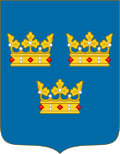Örebro
Örebro (/ˌɜːrəˈbruː/ UR-ə-BROO,[4][5][6] Swedish: [œrɛˈbruː] (![]()
Örebro | |
|---|---|
 | |
 Coat of arms | |
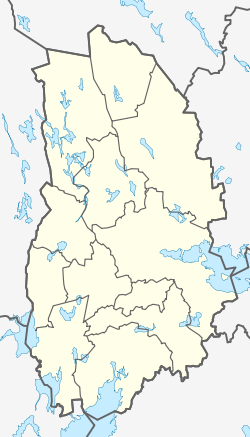 Örebro 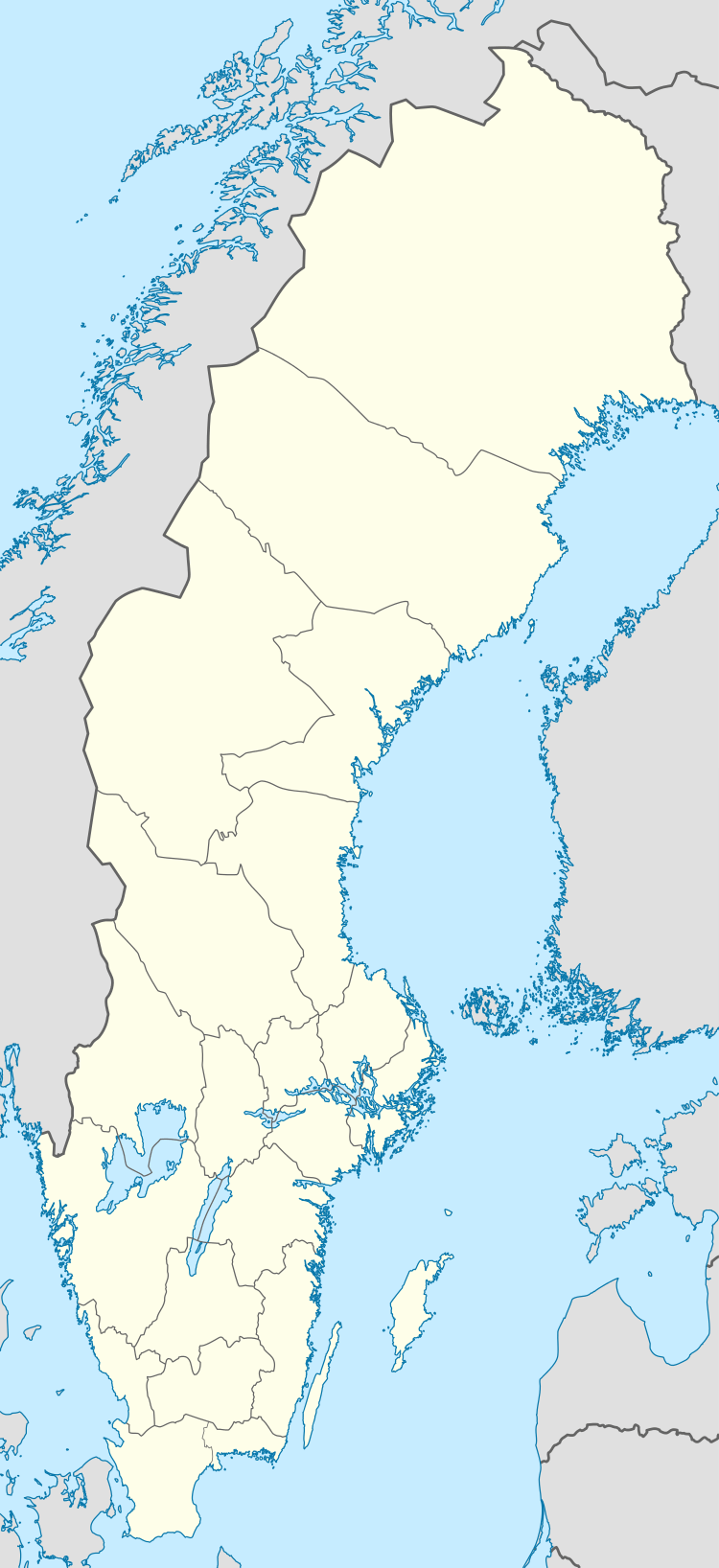 Örebro | |
| Coordinates: 59°16′26″N 15°12′27″E | |
| Country | Sweden |
| Province | Närke |
| County | Örebro County |
| Municipality | Örebro Municipality |
| Charter | 1404 |
| Area | |
| • City | 1,380.11 km2 (532.86 sq mi) |
| • Urban | 49.27 km2 (19.02 sq mi) |
| Elevation | 34 m (112 ft) |
| Population (2019)[2] | |
| • City | 155,989 |
| • Density | 2,172/km2 (5,630/sq mi) |
| • Urban | 125,817 |
| • Metro | 196,304[a] |
| Demonym(s) | Örebroare |
| Time zone | UTC+1 (CET) |
| • Summer (DST) | UTC+2 (CEST) |
| Postal code | 701 xx, 702 xx, 703 xx |
| Area code(s) | (+46) 19 |
| Website | www |
| ^ Including Örebro, Kumla, Hallsberg and Lekeberg municipalities. | |
Örebro is home to Örebro University, a major university hospital, a medieval castle, the water park Gustavsvik as well as several large shopping malls and the Oset-Rynningeviken nature reserve at the lakefront.
History

Örebro received its Royal Charter and city privileges not later than 1404.
The name Örebro refers to a bridge (bro) crossing the river Svartån where the city is located. The prefix Öre- is derived from ör 'gravel (bank)'.[8] The location became a natural seat of commerce in the Scandinavian Middle Ages and is mentioned in print in the 13th century. Old buildings from the early days include the foundations of the city church, a building which has undergone several modifications. The natural center of the city is otherwise the magnificent Örebro Castle, situated on an islet in the Svartån, and dividing the town into a northern and a southern part. This castle was constructed during the stewardship of Birger Jarl during the early 13th century and then modified and enlarged during the reign of King Gustav Vasa in the 1560s. The Örebro Synod was held here in 1529.
Notable events in Örebro's history include the national diet meeting at Örebro in 1810, where Jean-Baptiste Bernadotte was elected crown prince of Sweden.
Although a trade town, Örebro remained small until the second half of the 19th century, when it grew rapidly as a center of the national shoe-manufacturing industry (see: History of Närke).
Climate
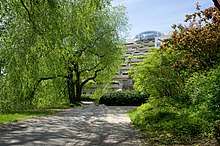
Örebro, like the rest of the area close to Mälardalen, has a humid continental climate (Köppen Dfb) that is made milder by the proximity to water and the Gulf Stream which makes it interchangeable with oceanic climates. Summer temperatures occasionally exceed 30 °C (86 °F) albeit not yearly, and temperatures above 5 °C (41 °F) are rare in winter, although frost-free nights sometimes occur. July high temperatures range from 20 °C (68 °F) to 26 °C (79 °F) depending on weather patterns, with a 2002–2014 mean high of around 23.4 °C (74.1 °F). During cold winters, Örebro receives plenty of snowfall. Örebro is far more prone than coastal areas to really harsh frosts with temperatures approaching or below −20 °C (−4 °F) happening almost every winter according to SMHI statistics. The station's setting in a rural location might skew temperatures somewhat compared to the urban area which is also at a slightly lower elevation and nearer Hjälmaren. Especially when considering overnight lows this could render a small urban heat island effect in the city centre.
However, the climate is very variable from year to year. For example, December 2010 was record cold with a daily mean of −9 °C (16 °F), whilst December 2006 only a few years before had a mean of 4.3 °C (39.7 °F).[9][10] The warmest month on record is 21.8 °C (71.2 °F) in July 2018 and the coldest on record is −12.8 °C (9.0 °F) in January 1987.[11][12] Örebro is often without snow cover for large parts of the winter months when daytime temperatures hover just above freezing – an exceptional feature for an inland area north of the 59th parallel.
The highest ever recorded temperature was set on 7 August 1975 during an intense heatwave with 36 °C (97 °F),[13] which is a very high temperature for such northerly parallels. During the 21st century, the record heat is 33.9 °C (93.0 °F) set on 8 August 2018.[14] The lowest recorded temperature in recorded history was set in February 1966 with −30 °C (−22 °F).[15] Several monthly records have been set in the 2010s according to official SMHI statistics, namely the record highs of March, May, July, October, November, December as well as the coldest December temperature and month on record, that was set in 2010.[16] The November record high of 2014 was associated with extremely unseasonal thunderstorms.[17] Humidity is high for most parts of the year, but adequately lower during summer months. In spite of this summer is generally the time that gets the most precipitation[18] due to clashes between hot and cool continental air systems causing heavy thunderstorm rainfall. In 2015, a 13.1 °C (55.6 °F) reading was recorded around the winter solstice, another record and a very warm reading for an inland area.[19]
| Climate data for Örebro Airport (2002–2018 averages; precipitation in the ward of Almby; extremes since 1901) | |||||||||||||
|---|---|---|---|---|---|---|---|---|---|---|---|---|---|
| Month | Jan | Feb | Mar | Apr | May | Jun | Jul | Aug | Sep | Oct | Nov | Dec | Year |
| Record high °C (°F) | 10.2 (50.4) |
12.4 (54.3) |
18.8 (65.8) |
26.9 (80.4) |
29.0 (84.2) |
34.0 (93.2) |
33.3 (91.9) |
36.0 (96.8) |
26.8 (80.2) |
20.2 (68.4) |
14.9 (58.8) |
13.1 (55.6) |
36.0 (96.8) |
| Mean maximum °C (°F) | 6.8 (44.2) |
6.8 (44.2) |
13.1 (55.6) |
19.5 (67.1) |
25.3 (77.5) |
27.3 (81.1) |
29.4 (84.9) |
28.4 (83.1) |
22.8 (73.0) |
16.7 (62.1) |
11.6 (52.9) |
8.2 (46.8) |
30.5 (86.9) |
| Average high °C (°F) | 0.4 (32.7) |
0.9 (33.6) |
5.5 (41.9) |
12.0 (53.6) |
17.6 (63.7) |
20.9 (69.6) |
23.5 (74.3) |
21.8 (71.2) |
17.4 (63.3) |
10.4 (50.7) |
5.4 (41.7) |
2.3 (36.1) |
11.5 (52.7) |
| Daily mean °C (°F) | −2.5 (27.5) |
−2.2 (28.0) |
1.2 (34.2) |
6.5 (43.7) |
11.7 (53.1) |
15.7 (60.3) |
18.0 (64.4) |
16.5 (61.7) |
12.5 (54.5) |
6.7 (44.1) |
2.7 (36.9) |
−0.5 (31.1) |
7.2 (45.0) |
| Average low °C (°F) | −5.4 (22.3) |
−5.3 (22.5) |
−3.1 (26.4) |
1.0 (33.8) |
5.8 (42.4) |
9.5 (49.1) |
12.4 (54.3) |
11.1 (52.0) |
7.6 (45.7) |
3.0 (37.4) |
0.0 (32.0) |
−3.2 (26.2) |
2.8 (37.0) |
| Mean minimum °C (°F) | −18.8 (−1.8) |
−15.7 (3.7) |
−12.3 (9.9) |
−5.9 (21.4) |
−1.3 (29.7) |
3.7 (38.7) |
6.9 (44.4) |
4.7 (40.5) |
−0.5 (31.1) |
−5.0 (23.0) |
−9.4 (15.1) |
−14.1 (6.6) |
−21.4 (−6.5) |
| Record low °C (°F) | −29.6 (−21.3) |
−30.0 (−22.0) |
−28.0 (−18.4) |
−14.5 (5.9) |
−5.6 (21.9) |
−1.2 (29.8) |
2.5 (36.5) |
0.0 (32.0) |
−5.7 (21.7) |
−12.8 (9.0) |
−19.5 (−3.1) |
−26.6 (−15.9) |
−30.0 (−22.0) |
| Average precipitation mm (inches) | 50.6 (1.99) |
38.2 (1.50) |
30.7 (1.21) |
35.2 (1.39) |
63.2 (2.49) |
62.2 (2.45) |
82.2 (3.24) |
85.7 (3.37) |
54.7 (2.15) |
62.8 (2.47) |
63.5 (2.50) |
54.4 (2.14) |
683.4 (26.9) |
| Source 1: SMHI Open Data[20] | |||||||||||||
| Source 2: SMHI average data 2002–2018[21] | |||||||||||||
Demography
Sites of interest
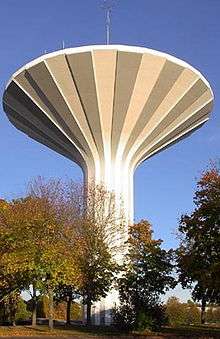
Örebro's old town, Wadköping, is located on the banks of the Svartån (black stream). It contains many 18th and 19th century wooden houses, along with museums and exhibitions. The water tower of Örebro, named Svampen (The Mushroom), is a popular destination as an outlook tower. In 1971, a replica of the tower was built in Riyadh, Saudi Arabia.
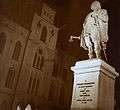 Rebel leader Engelbrekt in front of Örebro City Hall
Rebel leader Engelbrekt in front of Örebro City Hall Lindhska Bookstore in central Örebro
Lindhska Bookstore in central Örebro Centralpalatset, at the corner of Storgatan, one of Örebro's main streets
Centralpalatset, at the corner of Storgatan, one of Örebro's main streets
Culture
- Swedish Chamber Orchestra
- Örebro is the hometown of the punk-rock band Millencolin. They named one of their albums Pennybridge Pioneers, where Pennybridge stands for Örebro as a colloquial translation into English.
- Örebro is the hometown of various Swedish rock bands, such as Smash Into Pieces, Truckfighters, Blues Pills, Witchcraft, Troubled Horse and others, Graveyard's Lead Singer, Joakim Nilsson also was born in Örebro
- The influential and highly popular grind band Nasum were formed in Örebro.
- Örebro is one of the public broadcaster SVT's 12 local news districts and has television premises located in the city.
Örebro has hosted a contemporary art exhibition called Open Art on four occasions: in 2008, 2009, 2011 and 2013. In 2013, the exhibition featured works by 90 artists from Sweden and many other countries throughout the world.[22] The fifth edition of the exhibition is planned for the summer of 2015.[23]
Örebro University is one of Sweden's most recent, being upgraded from högskola (university college) in 1999. It currently has around 16,000 students and a staff of 1,100. The institution is regarded as one of the top 351–400 universities in the world.[24] The university is also named among the world's top 100 young universities (number 62) in the 2018 THE Young University Rankings.[25]
Gustavsvik, the largest water park in the Nordic countries, is located just a kilometer south of central Örebro. With more than 700,000 visitors per year, it is one of the most popular tourist and leisure establishments in Sweden. Only Liseberg, Gröna Lund and Skansen are more popular. In the summer the manor of Karlslund is a very popular place to visit.
Gallery

 Rudbeck Upper Secondary School's Main Building
Rudbeck Upper Secondary School's Main Building Karlslund Manor
Karlslund Manor
 Olaus Petri Church
Olaus Petri Church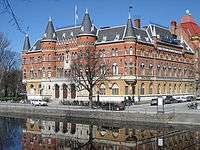 Nerikes Allehanda, the local newspaper's former offices in Örebro
Nerikes Allehanda, the local newspaper's former offices in Örebro View over Örebro Watertower Svampen with the mountain ridge Kilsbergen in the background
View over Örebro Watertower Svampen with the mountain ridge Kilsbergen in the background Allehandaborgen from Svartån river
Allehandaborgen from Svartån river
Sports
Football
- Örebro SK currently playing in Allsvenskan.
- Karlslunds IF currently play in Division 1 Norra.
- BK Forward currently playing in Division 2 Norra Svealand.
- Rynninge IK currently play in Division 2 Södra Svealand.
- Örebro Syrianska IF currently play in Division 2 Södra Svealand.
- FK Bosna 92 currently play in Division 3 Västra Svealand.
- Adolfsbergs IK currently play in Division 4 Örebro.
- IFK Örebro currently play in Division 4 Örebro.
- IK Sturehov currently play in Division 4 Örebro.
- Axbergs IF currently play in Swedish football Division 6 Norra.
Floorball
- Lillån IBK
- IBF Örebro
Other sports
- Örebro Volley play in the highest level of women's volleyball leagues in Sweden. They have won the league ten times.
- Örebro HK currently play in Swedish Hockey League (the highest level) since the 2013–14 season, having been promoted in the 2012–13 season.
- Örebro Black Knights are an American football Club that played in the Swedish Championship Finals in 1998, 1999, 2013, 2014, 2015, 2016 and 2017.
- Örebro Universitets IF Rugby
- Örebro SK Bandy has become national bandy champion five times, but nowadays play in Allsvenskan, the second highest division of Swedish bandy. The home matches are played in Behrn Arena, one of thirteen (as of 2017) indoor bandy arenas in Sweden.
Karlslunds IF is a multi-sports club specialising in American Football, Bandy, Baseball/Softball, Bowling, Football, Gymnastics, Skiing and Swimming.
Notable people
- Artists
- Josef Fares (born 1977), Lebanese-Swedish film director
- Mary Stävin (born 1957), James Bond girl, crowned as Miss World 1977
- Stephan Berg (born 1957), composer and songwriter, winner of Eurovision Song Contest 1991
- Jens Bogren (born 1979), record producer
- Ola Brunkert (1946–2008), drummer in ABBA
- Rob Marcello (born 1977), guitar player
- Nina Persson (born 1974), singer
- Mats Ronander (born 1954), singer, guitar player, and composer
- Dan Swanö (born 1973), singer and multi-instrumentalist
- Jasmine Kara (born 1988), singer
- Blues Pills (2011–present), rock band
- Dead Man (2003–present), psychedelic folk rock band
- Lolita Pop (1979–1992), rock band
- Millencolin (1992–present), punk rock band
- Nasum (1992–present), grindcore band
- Spetsnaz (2001–present), electronic band
- Truckfighters (2001–present), rock band
- Witchcraft (2000–present), doom metal band
- Politicians and public officials
- Henry Allard (1911–1996), politician
- Leni Björklund (born 1944), politician
- Engelbrekt Engelbrektsson, (1390s–1436), rebel leader and statesman
- Sten Tolgfors (born 1966), politician and businessman
- Olof Daniel Westling (Prince Daniel; born 1973), husband of Crown Princess Victoria
- Religion
- John Ongman (1844–1931), pastor
- Laurentius Petri (1499–1573), clergyman
- Olaus Petri (1493–1552), clergyman and reformer
- Scientists and engineers
- Manne Siegbahn (1886–1978), physicist
- Gunnar A. Sjögren (1920–1996), automobile designer
- Jonas Wenström (1855–1893), engineer and inventor
- Bertil Lindblad (1895–1965), astronomer
- Sportspeople
- Peter Andersson (born 1965), ice hockey player
- Christian Berglund (born 1980), ice hockey player
- Orvar Bergmark (1930–2004), football and bandy player
- Stig Blomqvist (born 1946), rally driver
- Hasse Borg (born 1953), football player
- Elisabeth Branäs (1930–2010), curler, two-time European champion
- Magnus Erlingmark (born 1968), football player
- Emilia Fahlin (born 1988), cyclist
- Richard Göransson (born 1978), racing driver
- Carl Gunnarsson (born 1986), ice hockey player
- Oscar Jansson (born 1990), football player
- Fredrik Lindgren (born 1985), motorcycle speedway rider
- Ludvig Lindgren (born 1990), motorcycle speedway rider
- Tomas Nordahl (born 1946), football player and commentator
- Ronnie Peterson (1944–1978), racing driver
- Johan Röjler (born 1981), ice speed skater
- Emra Tahirović (born 1987), Bosnian-Swedish football player
- Caroline Bergius (born 1989), handball player
- Borje Jansson (born 1942) racing motorcycle rider, winner of 4 World GPs
- Gabriel Carlsson (born 1997), National Hockey League defenseman for Columbus Blue Jackets (#53)
- Writers
- Hjalmar Bergman (1883–1931), writer and playwright
- August Gailit (1891–1960), Estonian writer
- Edita Morris (1902–1988), Swedish-American writer and political activist
- Emilie Risberg (1815–1890), novelist and educator
- Cajsa Warg (1703–1769), cookbook author
Twin towns – sister cities
Örebro is twinned with [26]
See also
- Örebro Municipality
- Nerikes Allehanda
- Julmust
- Brickebacken
- Olaus Petriskolan, a school in Örebro
References
- "Localities 2010, area, population and density in localities 2005 and 2010 and change in area and population". Statistics Sweden. 29 May 2012. Archived from the original on 16 January 2013.
- "Folkmängd i riket, län och kommuner 31 december 2019" (in Swedish). Statistics Sweden. 20 February 2020. Retrieved 20 February 2020.
- "Folkmängd och landareal i tätorter, per tätort. Vart femte år 1960 - 2019". Statistikdatabasen.
- "Örebro". The American Heritage Dictionary of the English Language (5th ed.). Boston: Houghton Mifflin Harcourt. Retrieved 14 April 2019.
- "Örebro" (US) and "Örebro". Oxford Dictionaries UK Dictionary. Oxford University Press. Retrieved 14 April 2019.
- "Örebro". Merriam-Webster Dictionary. Retrieved 14 April 2019.
- "Population in localities increased by 120 000". Statistiska Centralbyrån. Retrieved 15 November 2017.
- Wahlberg, Mats, ed. (2003). Svenskt ortnamnslexikon (PDF) (in Swedish) (1st ed.). Uppsala: Swedish Institute for Dialectology, Onomastics and Folklore Research. pp. 388–389. ISBN 91-7229-020-X. Retrieved 9 October 2017.
- "December – air temperature and wind (2010)" (PDF) (in Swedish). SMHI. Retrieved 28 July 2015.
- "December – air temperature and clouds (2006)" (PDF) (in Swedish). SMHI. Retrieved 28 July 2015.
- "July – air temperature and wind (July 2014 – all-time record section)" (PDF) (in Swedish). SMHI. Retrieved 28 July 2015.
- "January – air temperature and wind (2015 – all-time record section)" (PDF) (in Swedish). SMHI. Retrieved 28 July 2015.
- "August 2014 – Air Temperature and Wind" (PDF). Swedish Meteorological and Hydrological Institute (SMHI). Retrieved 19 February 2015.
- "August 2018 – Air Temperature and Wind" (PDF). Swedish Meteorological and Hydrological Institute (SMHI). Retrieved 15 April 2019.
- "February 2014 – Air Temperature and Wind" (PDF). Swedish Meteorological and Hydrological Institute (SMHI). Retrieved 19 February 2015.
- "December 2010 -Air Temperature and Wind" (PDF). SMHI. Retrieved 20 February 2015.
- "The crazy November weather – Record heat and Thunder (Swedish)". EWP.se. Retrieved 20 February 2015.
- "Average Precipitation for Stations (Swedish)". SMHI. Retrieved 20 February 2015.
- "13,1 – nytt värmerekord för Örebro" (in Swedish). Nerikes Allehanda. 20 December 2015. Retrieved 20 December 2015.
- "Meteorological observations". Swedish Meteorological and Hydrological Institute. Retrieved 15 April 2019.
- "Annual and Monthly Statistics". Swedish Meteorological and Hydrological Institute. Retrieved 15 April 2019.
- "OpenART 2015: Artists". openart.se.
- johan. "OpenART 2015: About". openart.se.
- "Rankings: Örebro University". Times Higher Education. Retrieved 20 July 2018.
- ”Young University Rankings 2018”. Times Higher Education. Retrieved 20 July 2018.
- "Vänorter" [Sister cities]. Örebro kommun [Örebro Municipality] (in Swedish). Archived from the original on 27 July 2009.:
- "Miasta partnerskie" [Twin Cities]. Urząd Miasta Łodzi [City of Łódź] (in Polish). Archived from the original on 24 June 2013.
External links
| Wikimedia Commons has media related to Örebro. |
| Wikivoyage has a travel guide for Örebro. |
| Wikisource has the text of the Encyclopaedia Britannica (9th ed.) article Örebro. |
- Official website

